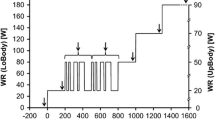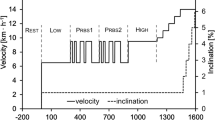Abstract
Purpose
Heart rate (HR), pulmonary and muscle oxygen uptake (\(\dot{V}\)O2pulm, \(\dot{V}\)O2musc) kinetics after changes of work rate (WR) indicate regulatory characteristics related to aerobic metabolism. We analysed whether the kinetics of HR, \(\dot{V}\)O2pulm and \(\dot{V}\)O2musc are slowed after missions to the International Space Station (ISS). The changes of the kinetics were correlated with \(\dot{V}\)O2peak data.
Methods
10 astronauts [4 females, 6 males, age: 48.0 ± 3.8 years, height: 176 ± 7 cm, mass: 74.5 ± 15.9 kg (mean ± SD)] performed an incremental test to determine \(\dot{V}\)O2peak (before missions on L-110 days, after return on R+1/+10/+36 days), and a cardio-respiratory kinetics test (CRKT) with randomized 30–80 W WR changes to determine HR, \(\dot{V}\)O2pulm and \(\dot{V}\)O2musc kinetics by time-series analysis (L-236/-73, R+6/+21). Kinetics were summarized by maximum and related lag of cross-correlation function (CCFmax, CCFlag) of WR with the analysed parameter.
Results
Statistically, significant changes were also found for CCFmax(\(\dot{V}\)O2musc) between L-236 and R+6 (P = 0.010), L-236 and R+21 (P = 0.030), L-72 and R+6 (P = 0.043). Between pre-to-post mission change in \(\dot{V}\)O2peak and CCFmax(HR), a correlation was shown (r SP = 0.67, P = 0.017).
Conclusion
The \(\dot{V}\)O2musc kinetics changes indicate aerobic detraining effects which are present up to 21 days following space flight. The correlations between changes in \(\dot{V}\)O2peak and HR kinetics illustrate the key role of cardiovascular regulation in \(\dot{V}\)O2peak. The addition of CRKT to ISS flight is recommended to obtain information regarding the potential muscular and cardiovascular deconditioning. This allows a reduction in the frequency of higher intensity testing during flight.






Similar content being viewed by others
Abbreviations
- (a-v)O2diff:
-
Arterio-venous difference in O2 concentration
- BDC:
-
Baseline data collection
- CCF:
-
Cross-correlation functions
- CCFlag :
-
Cross-correlation functions lags
- CCFmax :
-
Cross-correlation functions maxima
- CRKT:
-
Cardio-respiratory kinetics test
- ESA:
-
European Space Agency
- GXT:
-
Graded exercise test
- HR:
-
Heart rate
- ISS:
-
International Space Station
- L:
-
Launch
- NASA:
-
National Aeronautics and Space Administration
- O2 :
-
Oxygen
- PPFS:
-
Portable Pulmonary Function System
- PRBS:
-
Pseudo-random binary sequences
- \(\dot{Q}\) T :
-
Cardiac output
- \(\dot{Q}\) rem :
-
Perfusion
- R:
-
Return from space
- rSP :
-
Spearman’s rank correlation coefficients
- SV:
-
Stroke volume
- \(\dot{V}\)CO2pulm:
-
Pulmonary CO2 output
- \(\dot{V}\) E :
-
Ventilation
- \(\dot{V}\)O2 :
-
Oxygen uptake
- \(\dot{V}\)O2max:
-
Maximal oxygen uptake
- \(\dot{V}\)O2musc:
-
Muscular \(\dot{V}\)O2
- \(\dot{V}\)O2pulm:
-
Pulmonary oxygen uptake
- \(\dot{V}\)O2rem:
-
Model estimates for oxygen uptake
- Vven :
-
Venous blood volume between exercising muscles and lungs
- WR:
-
Work rate
References
Alfrey CP, Udden MM, Leach-Huntoon C, Driscoll T, Pickett MH (1996) Control of red blood cell mass in spaceflight. J Appl Physiol 81:98–104
Barstow TJ, Molé PA (1987) Simulation of pulmonary O2 uptake during exercise. J Appl Physiol 63:2253–2261
Barstow TJ, Lamarra N, Whipp BJ (1990) Modulation of muscle and pulmonary O2 uptakes by circulatory dynamics during exercise. J Appl Physiol 68:979–989
Barstow TJ, Buchthal S, Zanconato S, Cooper DM (1994) Muscle energetics and pulmonary oxygen uptake kinetics during moderate exercise. J Appl Physiol 77:1742–1749
Bassett DRJR, Howley ET (2000) Limiting factors for maximum oxygen uptake and determinants. Med Sci Sports Exer 32:70–84
Capelli C, Antonutto G, Kenfack MA, Cautero M, Lador F, Moia C et al (2006) Factors determining the time course of V’O2max decay during bedrest: implications for V’O2max limitation. Eur J Appl Physiol 98:152–160
Clemensen P, Christensen P, Norsk P, Gronlund J (1994) A modified photo and magnetoacoustic multigas analyzer applied in gas exchange measurements. J Appl Physiol 76:2832–2839
Cochrane JE, Hughson RL (1992) Computer simulation of O2 transport and utilization mechanisms at the onset of exercise. J Appl Physiol 73:2382–2388
Convertino V, Hung J, Goldwater D, DeBusk RF (1982) Cardiovascular responses to exercise in middle-aged men after 10 days of bedrest. Circulation 65:134–140
De Chantemèle EB, Pascaud L, Custaud MA, Capri A, Louisy F, Ferretti G, Arbeille P (2004) Calf venous volume during stand-test after a 90-day bed-rest study with or without exercise countermeasure. J Physiol 561:611–622
DeLorey DS, Kowalchuk JM, Paterson DH (2004) Effects of prior heavy-intensity exercise on pulmonary O2 uptake and muscle deoxygenation kinetics in young and older adult humans. J Appl Physiol 97:998–1005
DeLorey DS, Paterson DH, Kowalchuk JM (2007) Effects of ageing on muscle O2 utilization and muscle oxygenation during the transition to moderate-intensity exercise. Appl Physiol Nutr Metab 32:1251–1262
Di Prampero PE, Davies DTM, Cerretelli P, Margaria R (1970) An analysis of O2 debt contracted in submaximal exercise. J Appl Physiol 29:547–551
Drescher U, Koschate J, Hoffmann U (2015) Oxygen uptake and heart rate kinetics during dynamic upper and lower body exercise: an investigation by time-series analysis. Eur J Appl Physiol 115:1665–1672
Eßfeld D, Hoffmann U, Stegemann J (1991) A model for studying the distortion of muscle oxygen uptake patterns by circulation parameters. Eur J Appl Physiol 62:83–90
Ferretti G, Antonutto G, Denis C, Hoppeler H, Minetti AE, Narici MV, Desplanches D (1997) The interplay of central and peripheral factors in limiting maximal O2 consumption in man after prolonged bed rest. J Physiol 501:677–686
Fritsch-Yelle JM, Whitson PA, Bondar RL, Brown TE (1996) Subnormal norepinephrine release relates to presyncope in astronauts after spaceflight. J Appl Physiol 81:2134–2141
Grassi B (2006) Oxygen uptake kinetics: why are they so slow? And what do they tell us? J Physiol Pharmacol 57:53–65
Grassi B, Poole DC, Richardson RS, Knight DR, Erickson BK, Wagner P (1996) Muscle O2 uptake kinetics in humans: implications for metabolic control. J Appl Physiol 80:988–998
Hoffmann U, Drescher U, Benson AP, Rossiter HB, Essfeld D (2013) Skeletal muscle V’O2 kinetics from cardiopulmonary measurements: assessing distortions through O2 transport by means of stochastic work-rate signals and circulatory modelling. Eur J Appl Physiol 113:1745–1754
Hughson RL (2009) Oxygen uptake kinetics: historical perspective and future directions. Appl Physiol Nutr Metabol 34:840–850
Hughson RL, Shoemaker JK, Blaber AP, Arbeille P, Greaves DK, Pereira-Junior PP, Xu D (2012) Cardiovascular regulation during long-duration spaceflights to the International Space Station. J Appl Physiol 112:719–727
Inman MD, Hughson RL, Weisiger KH, Swanson GD (1987) Estimate of mean tissue O2 consumption at onset of exercise in males. J Appl Physiol 63:1578–1585
Lee SM, Moore AD, Everett ME, Stenger MB, Platts SH (2010) Aerobic exercise deconditioning and countermeasures during bed rest. Aviat Space Environ Med 81:52–63
Levine BD, Lane LD, Watenpaugh D, Gaffney F, Buckey JC, Blomqvist CG (1996) Maximal exercise performance after adaptation to microgravity. J Appl Physiol 81:686–694
Moore AD Jr, Lee SM, Charles JB, Greenisen MC, Schneider SM (2001) Maximal exercise as a countermeasure to orthostatic intolerance after spaceflight. Med Sci Sport Exerc 33:75–80
Moore AD, Downs ME, Lee SMC, Feiveson AH, Knudsen P, Ploutz-Snyder L (2014) Peak exercise oxygen uptake during and following long-duration spaceflight. J Appl Physiol 117:231–238
Petrini MF, Peterson BT, Hyde RW (1978) Lung tissue volume and blood flow by rebreathing theory. J Appl Physiol 44:795–802
Poole DC, Ferreira LF, Behnke BJ, Barstow TJ, Jones AM (2007) The final frontier: oxygen flux into muscle at exercise onset. Exerc Sport Sci Rev 35:166–173
Richardson RS, Noyszewski EA, Kendrick KF, Leigh JS, Wagner PD (1995) Myoglobin O2 desaturation during exercise—evidence of limited O2 transport. J Clin Invest 96:1916–1926
Rossiter HB, Ward SA, Doyle VL, Howe FA, Griffiths JR, Whipp BJ (1999) Inferences from pulmonary O2 uptake with respect to intramuscular (phosphocreatine) kinetics during moderate exercise in humans. J Physiol 518:921–932
Stegemann J, Essfeld D, Hoffmann U (1985) Effects of a 7 day head-down tilt (−6°) on the dynamics of oxygen uptake and Heart rate adjustment in upright exercise. Aviat Space Environ Med 56:410–414
Stegemann J, Hoffmann U, Erdmann R, Eßfeld D (1997) Exercise capacity during and after spaceflight. Aviat Space Environ Med 68:812–817
Trappe T, Trappe S, Lee G, Widrick J, Fitts R, Costill D (2005) Cardiorespiratory responses to physical work during and following 17 days of bed rest and spaceflight. J Appl Physiol 100:951–957
Trappe S, Costill D, Gallagher P, Creer A, Peters JR, Evans H, Riley DA, Fitts RH (2009) Exercise in space: human skeletal muscle after 6 months aboard the International Space Station. J App Physiol 106:1159–1168
Tschakovsky ME, Hughson RL (1999) Interaction of factors determining oxygen uptake at the onset of exercise. J Appl Physiol 86:1101–1113
Whipp BJ, Ward SA, Lamarra N, Davis JA, Wasserman K (1982) Parameters of ventilatory and gas exchange dynamics during exercise. J Appl Physiol 52:1506–1513
Acknowledgments
The study was supported by: the DLR (Deutsches Zentrum für Luft- und Raumfahrt), Germany (FKZ 50WB0726). We thank all astronauts for their collaborative participation in the experiments, all staff members of ESA, NASA and the Danish Aerospace Company for their support and engagement to realize this study.
Author information
Authors and Affiliations
Corresponding author
Ethics declarations
Conflict of interest
The authors declare that they have no conflict of interest.
Additional information
Communicated by Susan Hopkins.
U. Drescher and U. Hoffmann contributed equally to this work.
Rights and permissions
About this article
Cite this article
Hoffmann, U., Moore, A.D., Koschate, J. et al. \(\dot{V}\)O2 and HR kinetics before and after International Space Station missions. Eur J Appl Physiol 116, 503–511 (2016). https://doi.org/10.1007/s00421-015-3298-2
Received:
Accepted:
Published:
Issue Date:
DOI: https://doi.org/10.1007/s00421-015-3298-2




